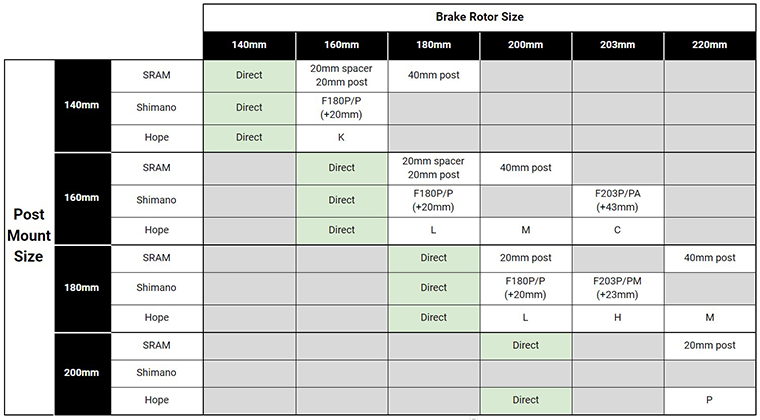So you've bought a new set of brakes or some larger rotors to install on your bike. It's as simple as just bolting them on and hitting the trails right? Well, not really. There are a few things to consider when installing different sized rotors and it's easy to get a little bamboozled by all the different options out there.
This article aims to arm you with enough knowledge to identify which type of brake mounts you have, what size they are, and which adaptor you'll need if you want to switch up your rotor size.
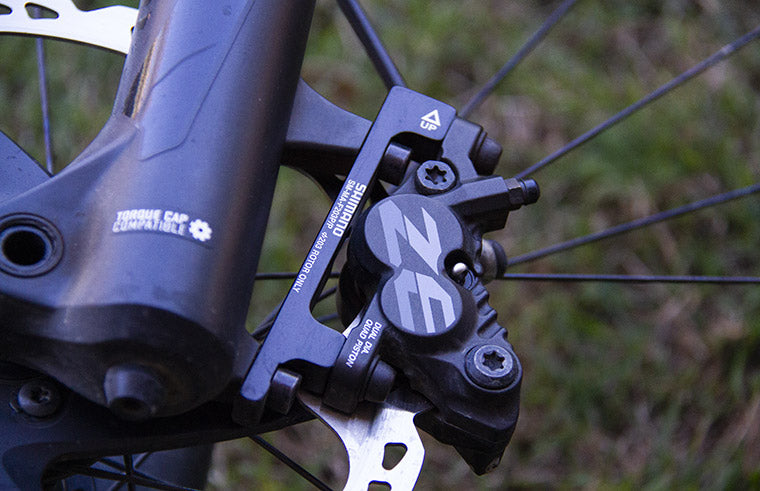
If you already know which mount size you have and just want a quick reference to help you choose the right adaptor I have prepared a Brake Mount Cheat Sheet just for you.
Check out our range of brake mounts here »
Check out our range of brake rotors here »
If anything on there doesn't make sense to you or you'd like to start from the beginning, then read on!
In this article we are going to cover:
- The main types of brake mounts
- Brand naming conventions
- Compatibility
- Working out which brake adaptor you need
The main types of brake mounts
To keep things as simple as possible we'll only discuss the two main types of brake mounts that you're likely to encounter on a modern MTB: IS and Post Mount.
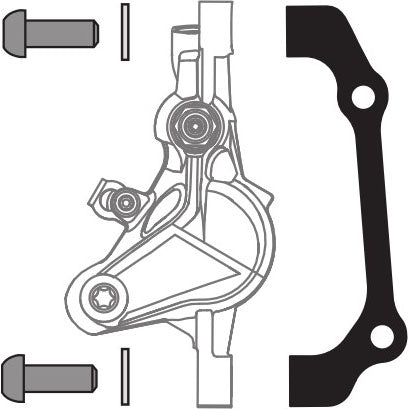
Standard IS Mount
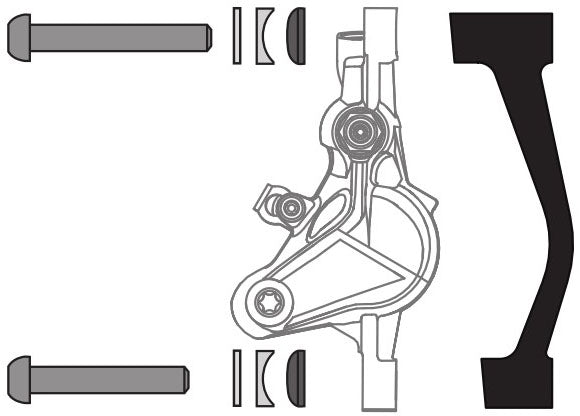
Standard 20mm with CPS
IS Mount
- Stands for International Standard
- Old school mounting system only really found on antique forks (circa 2000) and the rear of some modern frames (ie Banshee)
- Bolts are 51mm apart and bolt in perpendicular to the frame/fork.
- Fitting brake callipers requires an IS to Post Mount adaptor
IS (International Standard) mounts were the most common type used on bikes in the early 2000s but they've fallen out of favour in recent years. Fork manufacturers have switched completely to post mounts but IS mounts are still fairly common on the rear of some frames.
IS mounts have bolts that are 51mm apart and bolt in perpendicular to the frame/fork. All modern hydro disc brakes install via post mounts so you will need an IS to Post Mount adaptor to install your brakes on an IS mount.
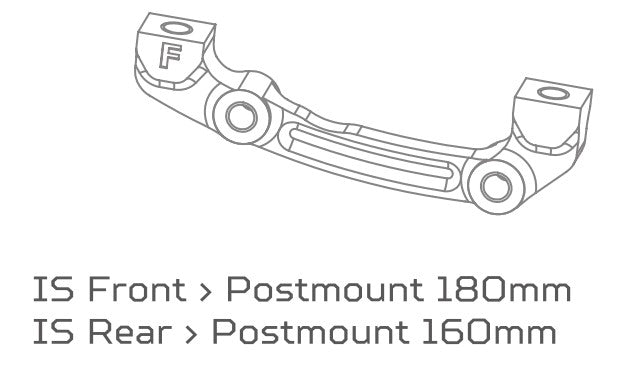
IS to post mount adaptors will often be listed as front or rear specific, or with different rotor sizes listed for each end. A front IS mount can be installed on the rear, but will only allow for a rotor 20mm smaller than if you had it on the fork keep that in mind if you find an F180mm IS to post mount adaptor in your mate's spares and want to use it for your rear brake.
Post Mount
- Found on most modern frames and forks
- Bolts are 74.2mm apart and screw directly into the frame/fork
- Brake calliper can mount directly without the need for an adaptor
- An adaptor is only required for rotors larger than the 'native' post mount size.
- Native post mount size could be anywhere from 140mm to 200mm depending on age, model, and intended use of the frame/fork.
- Most 2018+ 'Enduro' forks (Pike, Yari, Lyrik, 36, Helm, Bomber Z1 etc) tend to have 180mm post mounts.
- Most Trail, XC, and entry-level forks (SID, REBA, 34), and pre-2018(ish) Enduro forks have 160mm post mounts
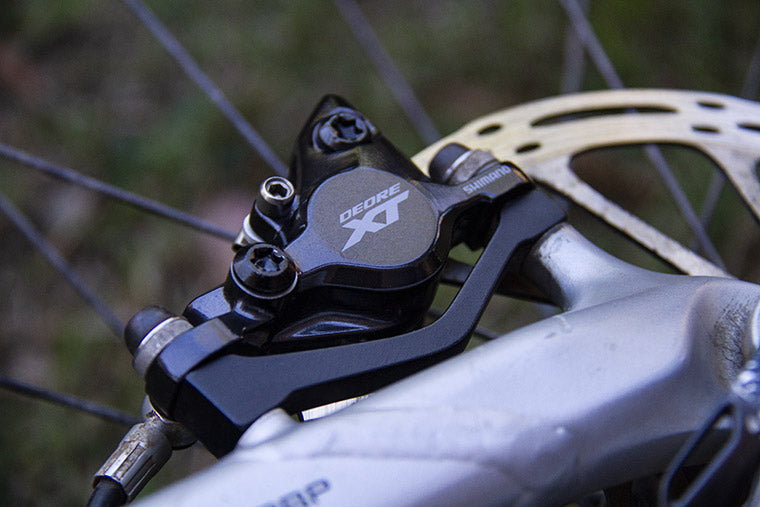
Most frames and forks you're likely to come across these days will have post mounts. The bolts are 74.2mm apart and screw directly into the frame or fork. The beauty of this system is that if the size of your rotor matches the native mounts on your bike you can mount the brake calliper directly without the need for an adaptor.
Up until 2018 or so, you could pretty much guarantee that your suspension fork would have 160mm post mounts and your frame would have 140mm, or possibly 160mm mounts. Many of the naming conventions for brake adaptors are based around the assumption that they'll be fitted to traditional sized 160mm mounts on the fork, and 140mm mounts on the frame.
Things have become much murkier over the last couple of years as brands are speccing larger native mounts to allow for the use of bigger rotors. It's not uncommon for modern Enduro bikes to have 180mm post mounts front and rear now, so that same adaptor that let you run 180mm rotors a few years ago could now let you run a 200mm rotor on either end.
Brand Naming Conventions
SRAM and Hope actually do a pretty good job at this and their naming conventions are quite easy to understand. Shimano's could do with some updating as they reference traditional post mount sizing which can cause a lot of confusion.
SRAM/Avid
SRAM/Avid win some solid points for utilising the KISS method with their adaptors. They simply state the amount of increase they provide, along with the mount type.
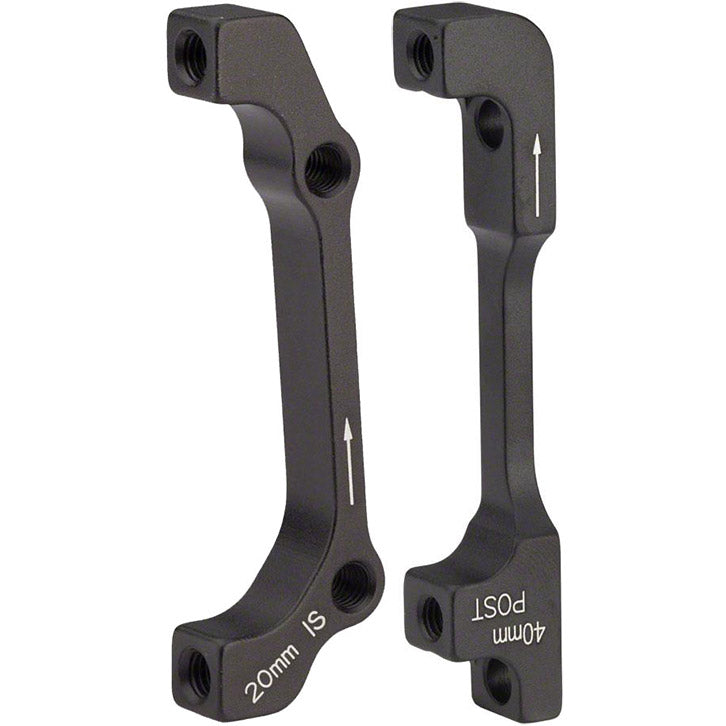
This way up! The arrow on your mounts should always point up or as close to up as you can get it.
Hope
Hope has a letter designation for each of their adaptors and a nice chart that clearly states what each one will do depending on which end of the bike it's mounted on. The letter is engraved onto each adaptor for easy identification.
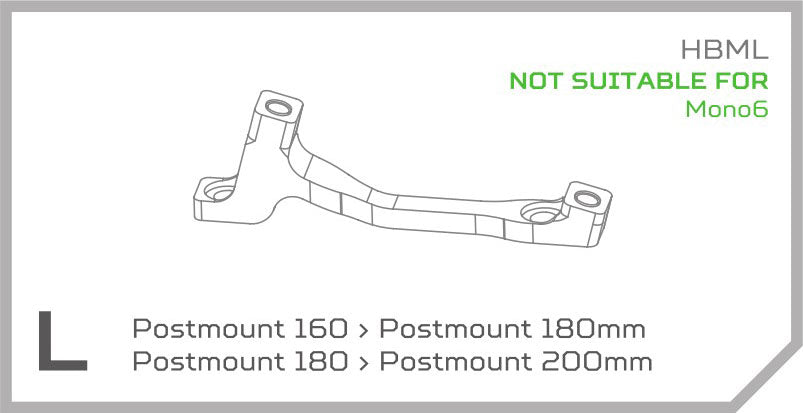
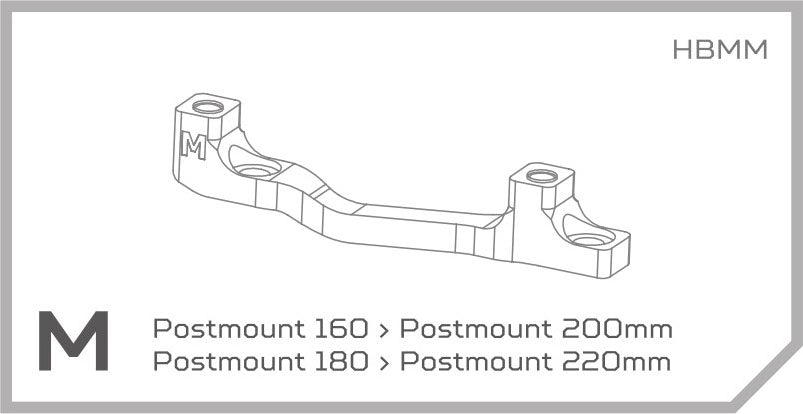
Check out our Hope brake mounts here »
Shimano
Shimano must like to make people suffer as all their adaptors are named with part numbers rather than something easy to understand for normal people. There is some useful information hidden inside those jumbles of numbers but it's not very intuitive. Their naming conventions are also based around traditional post mount sizing which causes a lot of head scratching now that there are so many different post mount sizes to consider.
Let's have a look at a few of their model names and break them down a bit.
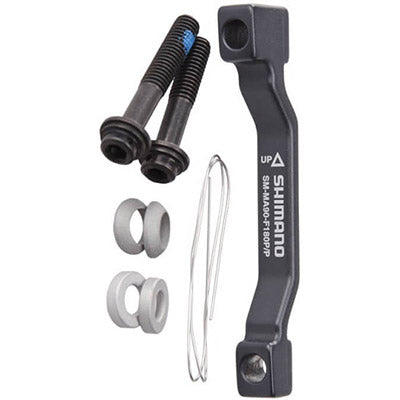
SM-MA90-F180P/P
- SMMA90: Shimano Mount Adaptor, Ultimate (XTR) Level
- F180P/P: Front, 180mm, Post to Post
This is an XTR level +20mm adaptor. The 180 assumes it will be installed on 160mm post mounts to run a 180mm rotor but it will add 20mm to whatever size post mounts it's used on.
Ultimate level models use a lighter alloy and have machined cutouts to save a tiny bit of weight. They also come with a bit of wire to wrap around the bolts to stop them coming loose (optional).
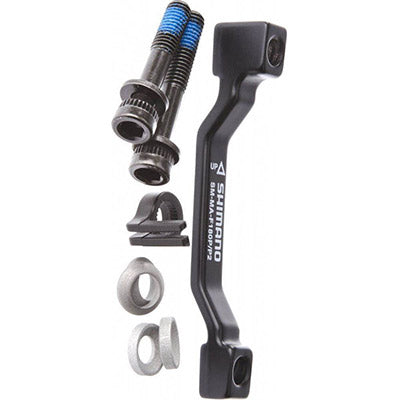
SM-MA-F180P/P2
- SM-MA: Shimano Mount Adaptor, Advanced (normal) Level
- F180P/P: Front, 180mm, Post to Post
This is an advanced (standard) level +20mm adaptor. Like the Ultimate level model above, the 180 assumes it will be installed on 160mm post mounts to run a 180mm rotor, but it will add 20mm to whatever size post mounts it's used on.
Advanced and Ultimate level models are totally interchangeable but Advanced level models are a teeny bit heavier (maybe a couple of grams). Advanced models also come with a plastic clip to go over one of the bolts to stop it coming loose (again this is optional).
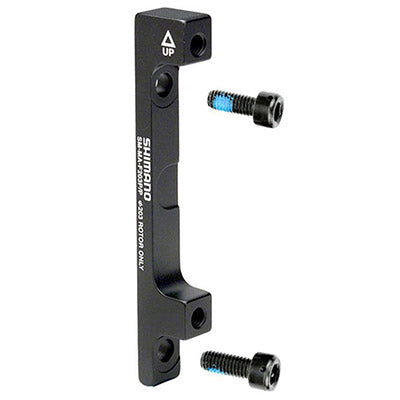
SM-MA-F203P/P
- SM-MA: Shimano Mount Adaptor, Advanced (normal) Level
- F203P/P: Front, 203mm, Post to Post
This is a +43mm adaptor. The 203 assumes it will be installed on 160mm post mounts to run a 203mm rotor. Note the offset mount and the four bolt holes? This is what gives it the extra reach to add that 43mm capacity to your rotor size.
Alrighty, we've got some kind of order happening here, and those numbers seem to make sense based on a 160mm post mount on our forks.
Let's try another one...
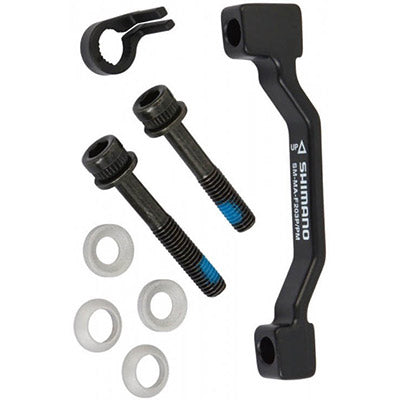
SM-MA-F203P/PM
- SM-MA: Shimano Mount Adaptor, Advanced (normal) Level
- F203P/P: Front, 203mm, Post to Post
- M: The M denotes that this is a +23mm adaptor rather than a +43mm like the other F203 adaptor above.
This mount will also let us run a 203mm rotor like the other F203 adaptor above, but it breaks the pattern we had going there. This adaptor is intended to be installed on 180mm post mounts and provides a 23mm increase to bump it up to 203mm. This confuses a lot of people as the model name is so similar to that first 203mm adaptor. Thanks Shimano!
Check out our Shimano brake mounts here »
Compatibility
It's always a good idea to match the brand of your brake mount with the brand of your brakes, but it's normally ok to mix things up a bit if you need to. Shimano brakes are ok on SRAM/Avid mounts and vice versa, and they will both work fine on Hope mounts.
Just be aware that SRAM make 200mm rotors and Shimano/Hope make 203mm so you might need to add some extra washers to run those 203's on your SRAM mount.
Hope brakes tend to run into clearance issues when installed on anything but Hope mounts. Their floating rotors definitely do not play nicely with anything other than Hope, so do yourself a favour and only run Hope brakes with Hope mounts.
Which brake adaptor do I need?
So now we know a bit about the different mount types and we're aware of those gotchas caused by old school naming conventions, it's time to look at our brakes to find out which adaptor we'd need to run larger rotors.
-
What size rotor is on there now?
The first thing to check is what size rotor you have. This is normally printed on the rotor itself and will be one of the following sizes:
- 140mm
- 160mm
- 180mm
- 183mm (Hope rotors only)
- 200mm
- 203mm
- 220mm
If it's super old and the markings have worn off you can check the diameter of the rotor by measuring from edge to edge through the centre of the rotor.
-
Is there an adaptor attached?
Looking at the size of the brake rotor and checking whether or not the brake calliper is attached directly should help you work out what size post mounts you're working with. If you have 180mm rotors currently installed you could quickly work out that:
- 180mm rotor and an adaptor = 160mm post mounts
- 180mm rotor and no adaptor = 180mm post mounts
There is a bit more to it if there is a 200mm or 203mm rotor attached as this will require an adaptor regardless of whether there are 160mm or 180mm post mounts. Thankfully +40mm/43mm adaptors have quite a distinctive shape and use an extra 2 bolts with an offset mount so they're pretty easy to spot.
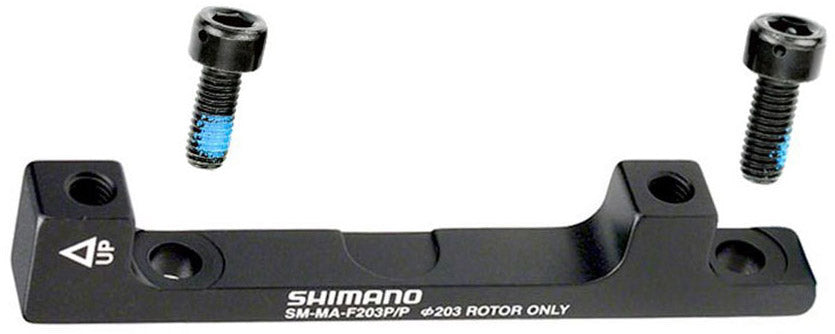
A Shimano 43mm adaptor. Note the offset mount and the two sets of bolt holes. -
What size rotor do you want to install? - How many millimetres of increase will there be?
So you've worked out what size post mounts you have, now think about what size rotor you want to install and how much of an increase it will be.
Say you have 160mm post mounts on your forks and want to run a 200mm rotor, that would be an increase of 40mm so you will need a +40mm adaptor.
Other amounts of increase might be:
- 160mm post mount: 180mm rotor = +20mm
- 160mm post mount: 183mm rotor = +23mm (Hope only)
- 160mm post mount: 200mm rotor = +40mm
- 160mm post mount: 220mm rotor = +60mm - Not possible
- 160mm post mount: 203mm rotor = +43mm
- 180mm post mount: 200mm rotor = +20mm
- 180mm post mount: 203mm rotor = +23mm
- 180mm post mount: 220mm rotor = +40mm
So when you're looking for a new brake mount and all the different options are getting confusing, just think about how much increase/decrease you need and look for a mount to suit. Don't rely on the model naming too much as it might be a bit misleading as we saw with some of those Shimano mounts above.
Hopefully, you're all sorted now and know how to confidently choose an adaptor to suit brakes of any size. Refer back to the cheat sheet above to find the mount to suit your needs based on which brand of brakes you have.
If you're still a bit lost feel free to reach out to our team at help@mtbdirect.com.au or hit us up on our online chat.


